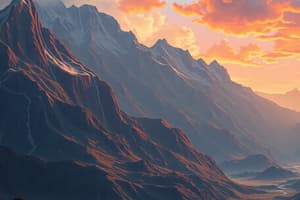Podcast
Questions and Answers
What is the primary process responsible for the formation of Block-Fault Mountains?
What is the primary process responsible for the formation of Block-Fault Mountains?
- Weathering and erosion
- Tectonic plate movements
- Volcanic eruptions
- Normal faulting caused by tension (correct)
Which of the following mountain types is formed through volcanic activity?
Which of the following mountain types is formed through volcanic activity?
- Appalachian Mountains
- Volcanic Mountains (correct)
- Fold Mountains
- Block-Fault Mountains
What is the primary geological process involved in the formation of mountains?
What is the primary geological process involved in the formation of mountains?
- Tectonic plate movements and volcanic activity (correct)
- Denudation and deposition
- Glaciation and permafrost
- Weathering and erosion
What is the characteristic that distinguishes hills from mountains?
What is the characteristic that distinguishes hills from mountains?
What type of mountains are formed when two or more tectonic plates are pressed together?
What type of mountains are formed when two or more tectonic plates are pressed together?
Which of the following is NOT a type of landform?
Which of the following is NOT a type of landform?
What is the term for the process of the Earth's lithosphere breaking into normal faults, resulting in the uplifting of blocks of rock?
What is the term for the process of the Earth's lithosphere breaking into normal faults, resulting in the uplifting of blocks of rock?
What is the characteristic of plateaus?
What is the characteristic of plateaus?
Which of the following is NOT a characteristic of mountains?
Which of the following is NOT a characteristic of mountains?
What is the term for mountains formed when magma from deep within the Earth's crust erupts onto the surface?
What is the term for mountains formed when magma from deep within the Earth's crust erupts onto the surface?
How can mountains be classified?
How can mountains be classified?
Which mountain range is an example of block-fault mountains?
Which mountain range is an example of block-fault mountains?
Study Notes
Mountains in Geography: Formation, Types, and Landforms
Formation
Mountains are formed through various geological processes, primarily involving tectonic plate movements and volcanic activity. They are landforms that rise prominently above their surroundings, typically exhibiting steep slopes, a confined summit area, and considerable local relief. The formation of mountains can be attributed to four main processes: folding, volcanism, and faulting.
- Folding: Mountains can form when two or more tectonic plates are pressed together, causing sedimentary rock to fold upwards into a series of bends and folds. This results in the formation of fold mountains, such as the Himalayas and the Alps.
- Volcanism: Volcanic mountains are created when magma from deep within the Earth's crust erupts onto the surface, forming a mountain as the lava cools and solidifies. Examples include Mount Everest in the Himalayas and Mount Fuji in Japan.
- Faulting: Block-fault mountains form when tension causes the Earth's lithosphere to break into normal faults, resulting in the uplifting of blocks of rock. Examples of block-fault mountains include the Sierra Nevada range in California and the Harz Mountains in Germany.
Types
Mountains can be classified into several types based on their formation and geological characteristics:
- Fold Mountains: Formed when two or more tectonic plates are pressed together, resulting in the folding of sedimentary rock. Examples include the Himalayas, the Alps, and the Appalachian Mountains.
- Volcanic Mountains: Formed when magma from deep within the Earth's crust erupts onto the surface, resulting in the formation of volcanic cones or shield volcanoes. Examples include Mount Everest, Mount Fuji, and Mount St. Helens.
- Block-Fault Mountains: Formed when tension causes the Earth's lithosphere to break into normal faults, resulting in the uplifting of blocks of rock. Examples include the Sierra Nevada range in California and the Harz Mountains in Germany.
Landforms
Mountains can also be classified as major landforms, which are features on Earth's surface that are part of the terrain. The four major types of landforms are mountains, hills, plateaus, and plains.
- Mountains: Mountains are landforms that rise prominently above their surroundings, generally exhibiting steep slopes, a relatively confined summit area, and considerable local relief.
- Hills: Hills are landforms that are smaller than mountains, typically having a lower elevation and less steep slopes.
- Plateaus: Plateaus are flat-topped landforms that stand high but contain little relief, such as the Altiplano in southern Peru and western Bolivia.
- Plains: Plains are flat, low-lying areas that cover large expanses of land, such as coastal plains and high plateaus.
In summary, mountains are landforms that rise prominently above their surroundings, exhibiting steep slopes, a confined summit area, and considerable local relief. They are formed through tectonic plate movements and volcanic activity, and can be classified into different types based on their formation and geological characteristics. Additionally, mountains can be classified as major landforms, including mountains, hills, plateaus, and plains.
Studying That Suits You
Use AI to generate personalized quizzes and flashcards to suit your learning preferences.
Description
Learn about the formation of mountains through geological processes, types of mountains including fold, volcanic, and block-fault, and how they are classified as major landforms. Discover the characteristics of mountains, hills, plateaus, and plains.




